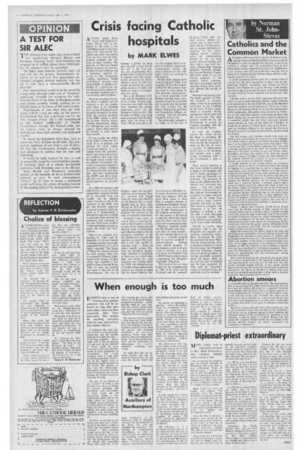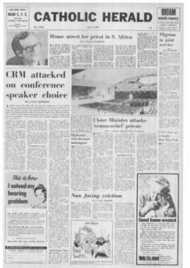Page 4, 2nd July 1971
Page 4

Report an error
Noticed an error on this page?If you've noticed an error in this article please click here to report it.
Tags
Share
Related articles
To Help Hospital
Catholic Nurses' Guild
Hospital Is 99
St. John's And St. Elizabeth's Hospital
Grand Master Praises Hospital's Concern
Crisis facing Catholic hospitals
by MARK ELWES
ANYONE going down Grove End Road in St. John's Wood who is dismayed by the sight of the crumbling facade of the Hospital of St. John and St. Elizabeth may draw consolation from the fact that the independent hospitals are not alone in their troubles. The majority of National Health Service hospitals are burdened with obsolete buildings and a mounting appetite for money to buy increasingly complex equipment. Rapid technological progress may bring benefits to patients undreamt of a generation ago but the enormous capital outlay and high running costs involved bring other problems.
These developments favour the larger hospitals and the tendency is for the smaller units either to be absorbed into a group of hospitals or to disappear altogether. In either event the familiar problems of the NHS remain—a shortage of beds, doctors, nurses, casualty departments; delays for orthopaedic and routine surgery, which often have to be counted in years rather than months.
No-one doubts the ability of the NHS to tend the seriously ill or to perform and develop the most sophisticated procedures; it is in routine work like geriatrics. minor operations and preventive medicine that gaps may be found. Small wonder that the affluent increasingly subscribe to insurance schemes to guarantee private treatment for themselves and their families, and that organisations like BUPA and those hospitals that cater exclusively for private patients are flourishing In a different category and infinitely less secure are those independent hospitals founded by charitable trusts and usually run by religious orders. Unable to call on the resources of the NHS, they are only partially supported by private patients simply because it is fundamental to their philosophy that inability to pay must never prevent the admission and treatment of the sick. Their basic problem is that expenditure exceeds income; the books just don't balance.
This is the situation confronting St. John and St. Elizabeth. Of all the Catholic hospitals none has a more distinguished history or is more highly regarded. The Sisters of Mercy first became known for their nursing when they accompanied Florence Nightingale to the Crimea. On their return they founded a hospital in Great Ormond Street. Then, as now, the hospital was open to the sick of all denominations. The cost of keeping a patient in those days was £25 a year! But by the end of the 19th century the neighbouring Hospital for Sick Children needed to expand, and with characteristic generosity the Sisters offered to move. In 1898 they bought the present site, adapted the house as a hospital and built two wings to accommodate new wards. This is the Hospital of St. John and St. Elizabeth as we know it today. Various additions have been built over the years including the convent generously given by the Brampton Trust in 1911. The Knights of Malta have long been associated with the Hospital; when the move to St. John's Wood took place, the Knights, under the energetic direction of Sir George Bowyer, removed their chapel stone by stone and rebuilt it on the present site—a considerable feat in those days. During the 1914-18 war, with typical patriotism, the entire hospital was devoted to the care of wounded servicemen. Financial crises have. of course, been a recurring feature in the Hospital's history, in spite of the continuous and devoted work of benefactors and voluntary helpers; but the changing conditions of the last decade have brought the situation to a head. The problem is not only rapidly increasing costs — there are others equally serious. Patients are becoming increasingly reluctant to contribute to their stay in a ward when they can obtain the same treatment for nothing under the NHS; the widespread use of modern drugs means more patients are treated at home and the School Medical Ser vice has happily led to a decline in children's admissions. Consequently neither the men's medical nor the children's wards are working to full capacity. Should these changes have been anticipated? There is no escaping the fact that responsibility for the present situation must to some extent lie with previous managements. In a recent interview Lord Robens said that senior management should be concerned not so much with the present but with looking into the future, anticipating problems and formulating policies accordingly. This the Hospital singularly failed to do. The philosophy seemed to be soldier on in the face of ever-increasing difficulties until events themselves imposed their own solution. Over the years there seems to have been a complete absence of entrepreneurial talent, though there has never been a shortage of able businessmen in the Catholic community — or for that matter in the Jewish community which has always had close links with the Hospital and donated generously. Whatever financial liabilities the Hospital may have— and they are bad enough— the fact remains that it is sitting on a valuable freehold that by current standards is under-employed. Perhaps sonic radical property redevelopment might have provided a solution; or a deal with either the Nuffield Trust or BUPA that would not have compromised the Hospital's charitable obligations. The situation has not been helped by the amalgamation in 1968 of St. John and St. Elizabeth with St. Andrew's Hospital, Dollis Hill. The chief motive behind thi; scheme was to form a hospital with the 300 beds necessary to secure continuing recognition for the nurses' training school. thifortunately, the amalgamation proved to be an even greater financial burden and after only a year both hospitals resumed their separate identities. Ironically enough, the General Nursing Council still treats them as one for nursing purposes, so the training school continues. But these vicissitudes and the uncertain future have inevitably affected the morale of the staff.
What does the future hold? The whole question of Catholic hospitals is currently under review by a committee established by the Cardinal; on the basis of their report, which is expected shortly, negotiations will be held with the Government. The ideal solution would he for the Government to absorb the Catholic hospitals with the National Health Service.
As with the Catholic schools this would involve the State in providing the bulk of capital and running costs leaving the hospitals to make up the rest. In return a measure of independence would have to be sacrificed. But whether such a policy would recommend itself to the Government is open to doubt.
Their present thinking is that funds should be devoted to large or new hospitals and not 'to rescue operations for those that are basically uneconomic. The practical effects of this philosophy have already been witnessed elsewhere — and even Queen Charlotte's is threatened by it. But without Government intervention or unless sufficient funds can be raised from new sources, many Catholic hospitals will have to close. This would be a tragedy. The alternative is to face the challenge of finding a new role that is both charitable and financially viable. This is the dilemma now confronting St. John and St. Elizabeth.
Clearly, to resolve these arguments and to put the Hospital's case requires outstanding negotiating talent. Here, fortunately the crisis has produced the man. Whatever the disagreements, there is unanimous praise for Lord Gainsborough, the Hospital's able new Chairman. Acutely aware of all the problems, he remains guardedly optimistic about the future. With the national shortage of hospitals and the high reputation St. John and St. Elizabeth's enjoys in medical circles, his optimism may be justified.
blog comments powered by Disqus









